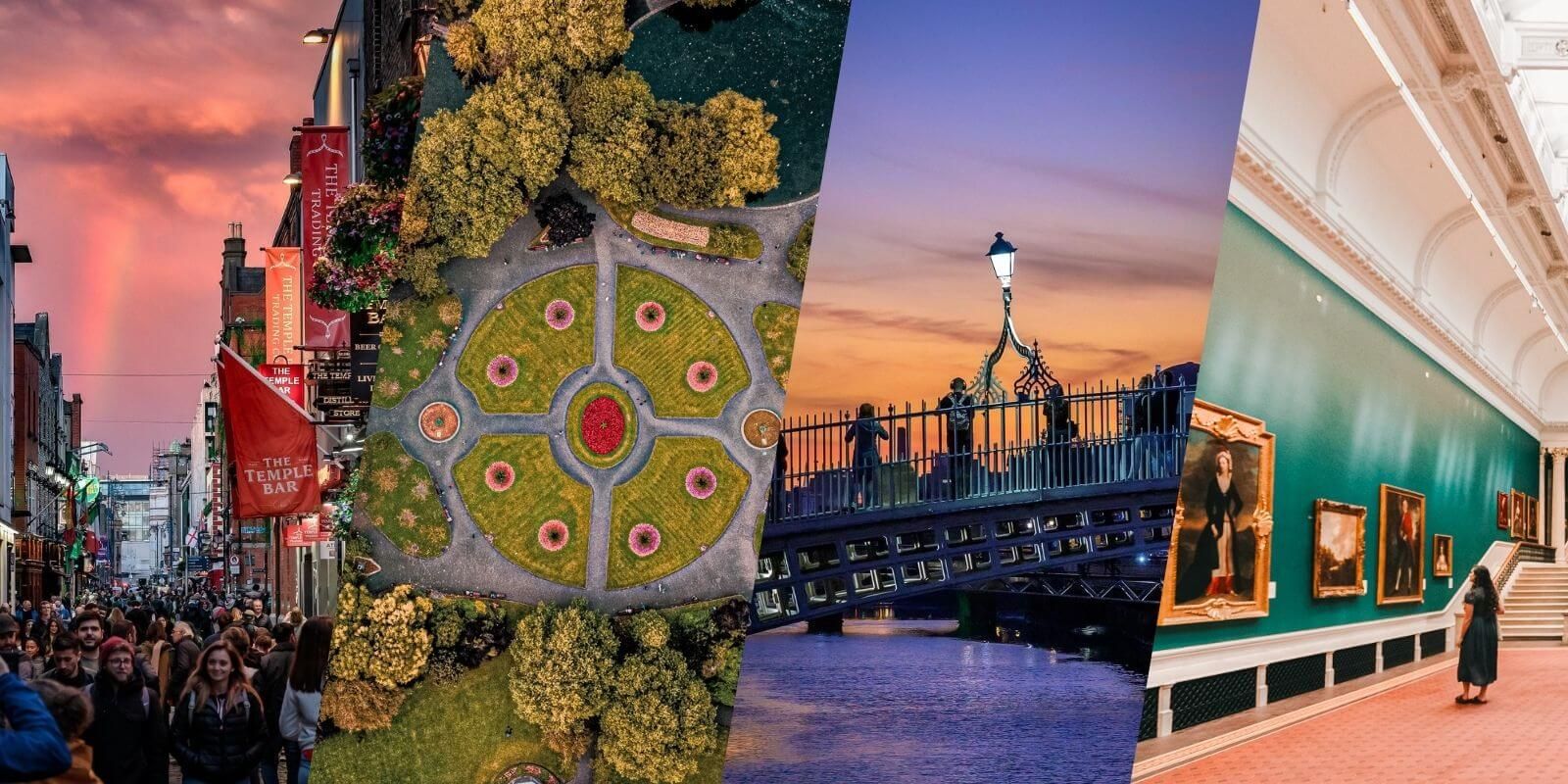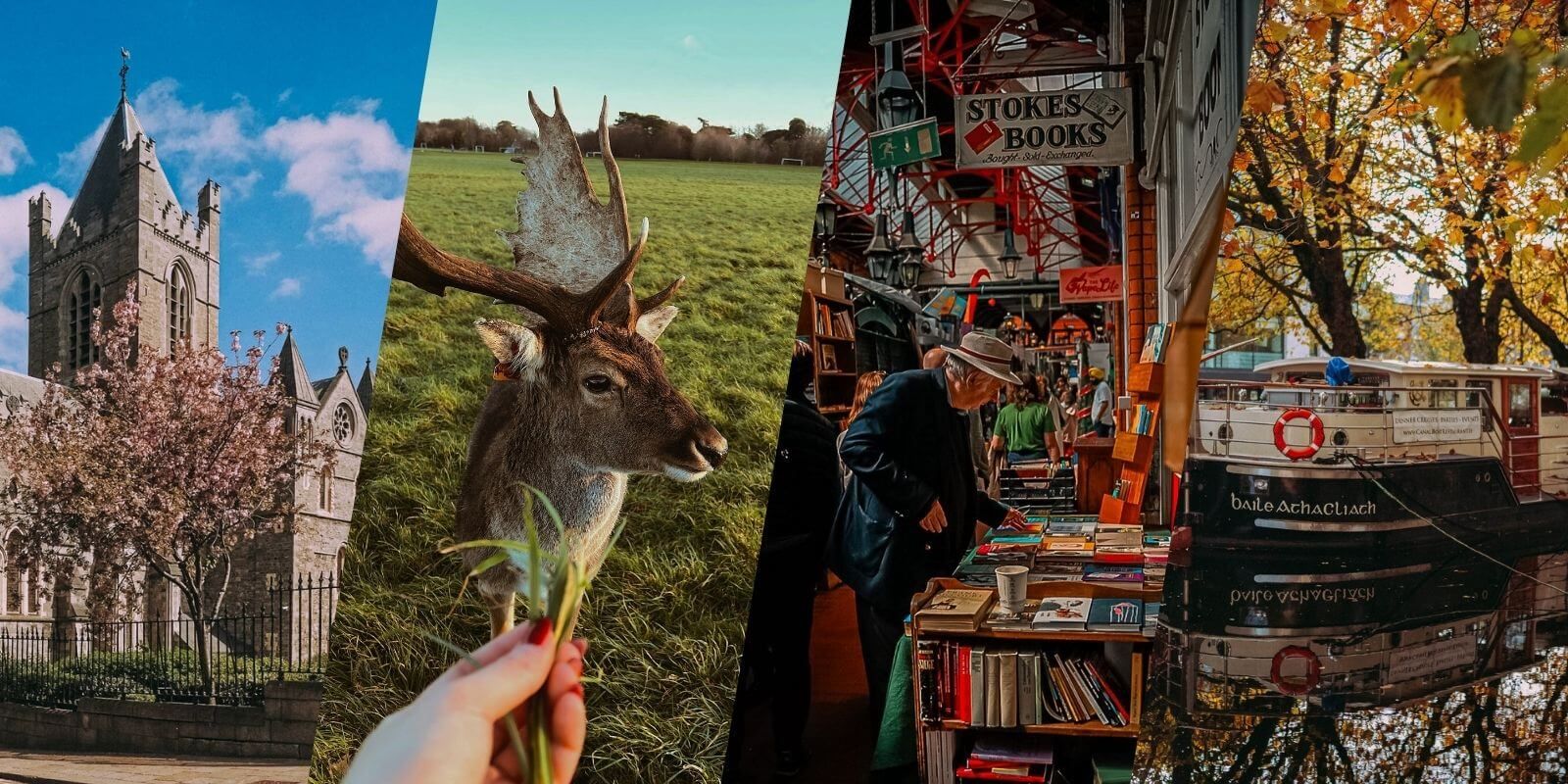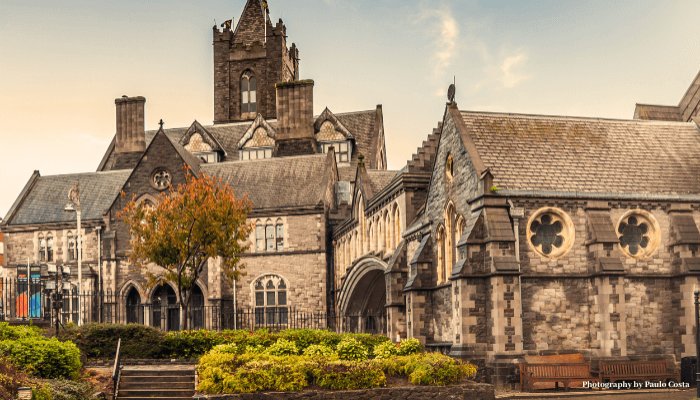The Story of Dublin: From Viking Roots to Vibrant Capital
-
Rich historical layers from Viking beginnings to modern vibrancy: Discover how Dublin evolved from a Viking Longport established around 841 AD, through Gaelic and Norman influences, to become Ireland’s bustling capital blending ancient heritage with a lively contemporary culture.
-
Key landmarks and periods shaping Dublin’s identity: Learn about Dublin’s original Irish names like “Dubh Linn” and “Baile Átha Cliath”, the impact of the Georgian architectural era, the Great Famine’s effect on the city, the 1916 Easter Rising and iconic sites like Dublin Castle and the Ha'penny Bridge.
-
A city alive with culture, history and community today: Explore how modern Dublin honours its literary giants, revolutionary past and Viking roots through attractions like Dublinia Viking Museum, while offering a cosmopolitan atmosphere full of pubs, music, tech hubs and friendly locals.
The Story of Dublin: From Viking Roots to Vibrant Capital
Welcome to Dublin, the beating heart of Ireland, a city where ancient legends, literary giants and buzzing modern life all blend together like a perfect pint of Guinness. Whether you’re planning a backpacking adventure through the cobbled streets of Temple Bar or you're just curious about the history behind the city’s name, Dublin has layers of fascinating stories waiting to be uncovered. From Viking invasions and Gaelic roots to revolutionary heroes and tech start-ups, this city has seen it all, and still manages to keep its charm, wit and character. Let’s take a walk through time and explore the story of Dublin in seven essential chapters.
When Was Dublin Founded?
Dublin, the capital of Ireland, has roots that stretch back over a thousand years. While the area was inhabited long before any written record, the official founding of Dublin dates to around 841 AD, when Scandinavian Vikings established a Longport (a type of temporary naval base used to overwinter during their raids and trading expeditions). This marked the beginning of Viking Dublin.
However, in 902 AD, the Vikings were expelled from the area and many fled to the north of England. But they weren’t gone for long. In 917 AD, the Norsemen made a strong return, successfully re-establishing their settlement. From that point, Dublin began to grow steadily into a more permanent and organised town, setting the stage for what would become one of the most important cities in Ireland.
Although it started as a Viking Longport, Dublin quickly evolved, influenced by both Norse and Gaelic cultures, and eventually laid the foundation for the vibrant, multicultural city we know today.
What Is the Old Irish Name for Dublin?
Dublin’s history stretches back over a thousand years, and with it comes a fascinating mix of names shaped by Gaelic, Viking and later English influences. The original Irish name for Dublin is “Dubh Linn”, which means “black pool” in Gaeilge (Irish). This name came from a dark, marshy pool where the River Poddle flowed into the River Liffey, an area thought to be stained black by decaying plant matter. This pool was located near what is now Dublin Castle, right in the heart of the modern city.
Interestingly, the Irish name used today, “Baile Átha Cliath”, translates as “town of the hurdled ford”, referring to a crossing point over the Liffey made from interwoven wattle hurdles. This was the name of a nearby Gaelic settlement that existed before the Vikings arrived. So while Dubh Linn and Áth Cliath are often used interchangeably today, they originally described two separate settlements that later merged into what we now know as Dublin.
What Did the Vikings Call Dublin?
When the Vikings invaded Ireland in the 9th century, they established their own fortified settlement right at the site of Dubh Linn. Adapting the Gaelic name to fit their Norse tongue, they called it “Dyflin”, their version of Dubh Linn. This became the name of their thriving Viking port and trading hub, where longboats would dock and goods like silver, textiles and slaves were exchanged.
From Dyflin, the Norse expanded their influence, turning the city into a key centre of power along the Irish coast. Their legacy remains visible today in place names, archaeological finds and Dublin’s Viking history tours. The name Dyflin faded over time, but echoes of it live on in historical records and bilingual street signs, offering a reminder of Dublin’s layered past and multicultural origins.
How Is Dublin Divided?
Dublin is traditionally divided by the River Liffey, which runs west to east through the city. This creates the well-known split between the Northside and Southside.
• The Northside includes areas like Drumcondra, Phibsborough and Smithfield. It’s known for its working-class roots, Georgian terraces and strong Dublin accents.
• The Southside includes more affluent neighbourhoods like Ballsbridge, Ranelagh and Rathmines, though areas like The Liberties and Portobello keep its character diverse and grounded.
• Dublin is also administratively divided into postal districts (Dublin 1, Dublin 2, etc.), with odd numbers generally on the Northside and even numbers on the Southside.
• Greater Dublin also spans Dublin City, Dún Laoghaire, Rathdown, Fingal and South Dublin County, especially when talking about modern governance.
This division often sparks light-hearted rivalry between Northsiders and Southsiders (expect a few jokes and friendly banter about it in local pubs).
Dublin’s Medieval and Norman Past
After the Viking age, it was the Normans who truly reshaped Dublin in the 12th century. Led by Strongbow, also known as Richard de Clare, the Normans arrived in 1170 and swiftly took control of the city. Dublin soon became the centre of English rule in Ireland, a role it would hold for centuries. One of the Normans’ most lasting legacies is Dublin Castle, which they began building in 1204 on the site of the old Viking fortress. The castle served as the seat of British administration in Ireland for over 700 years, right up until Irish independence in 1922. During this period, Dublin evolved into a walled medieval city with narrow winding streets and busy trade links to England and mainland Europe. Even today, as you wander through Dublin city centre, you’re following street layouts originally mapped out by the Normans. It’s a brilliant reminder of just how layered and living Dublin’s history really is.
Dublin and the Great Famine (1845–1852)
While the Great Famine is often associated with rural Ireland, Dublin was deeply affected in its own way. As people fled starving regions in the west and south, the capital saw a huge influx of migrants seeking refuge. Thousands arrived with little more than hope, overcrowding already struggling neighbourhoods like The Liberties and the North Inner City.
This sudden population spike led to worsening poverty, disease and urban hardship. The city’s workhouses and hospitals were overwhelmed and diseases such as cholera and typhus spread rapidly in the cramped tenements. Charities and religious groups did their best to help, but the scale of suffering was immense. The famine left long-term scars, deepening the divide between rich and poor and reshaping Dublin’s urban development.
Today, the impact of the Famine can still be felt and seen in parts of the city. Sites like the Famine Memorial along the River Liffey and records from institutions like the South Dublin Union (now St. James’s Hospital) offer a sombre reminder of how the capital faced one of Ireland’s darkest chapters.
Dublin's Georgian Era
In the 18th century, Dublin experienced a period of architectural elegance and cultural growth known as the Georgian Era. During this time, many of the city’s finest buildings were constructed, especially around Merrion Square, Fitzwilliam Square and Henrietta Street. These areas remain some of the most beautiful parts of the city, with classic red-brick Georgian townhouses, decorative doorways and wrought-iron balconies. Dublin’s Georgian past is still a huge draw for visitors and historians alike. This period left a lasting mark on Dublin’s identity, and today, it continues to fascinate both visitors and architecture lovers.
What many might not realise is that Gardiner House Hostel is located in one of these original Georgian buildings, offering guests the chance to stay in a real piece of Dublin’s architectural history.
Dublin During British Rule and the Path to Independence (1916 Easter Rising)
From the 17th to early 20th century, Dublin was a city of contradictions. It was both the seat of British power in Ireland and a hotbed of resistance. Grand Georgian architecture emerged in areas like Merrion Square and Mountjoy Square, showcasing Dublin’s wealth. Yet, poverty was rampant in areas like The Liberties.
One of the most pivotal moments in Irish history, the 1916 Easter Rising took place primarily in Dublin. Armed Irish republicans seized key buildings across the city, including the General Post Office (GPO) on O’Connell Street, and proclaimed an independent Irish Republic. The Rising was crushed after six days, but it sparked a chain of events that led to Irish independence just a few years later. Today, bullet holes from the fighting can still be seen on the GPO's façade, and the event is commemorated with memorials and annual ceremonies. This topic is a must for anyone exploring revolutionary Dublin history or the road to Irish independence.
Dublin in the Irish Civil War
Shortly after the Irish War of Independence, Dublin became a battleground once again during the Irish Civil War (1922–1923). Conflict broke out between pro- and anti-Treaty forces after the signing of the Anglo-Irish Treaty. The fighting began in Dublin when the new Irish government shelled the Four Courts, which had been occupied by anti-Treaty forces. This dramatic start to the Civil War left parts of the city scarred and deeply divided, with long-lasting political consequences.
The Ha'penny Bridge: Dublin’s Iconic Pedestrian Crossing
Built in 1816, the Ha'penny Bridge is one of Dublin’s most iconic landmarks. It was the first pedestrian bridge to span the River Liffey, and it got its nickname from the original half-penny toll pedestrians had to pay to cross it. Today, it’s free and a top selfie spot, a romantic and nostalgic symbol of old Dublin that still connects both sides of the city.
Modern Dublin: A City of Culture, Craic and Community
Today, Dublin is a vibrant capital known for its literary history, live music, pub culture and welcoming atmosphere. It’s the birthplace of James Joyce, Oscar Wilde and Samuel Beckett – and the home of Guinness, Temple Bar and Trinity College. The city has grown into a hub for tech companies, education, tourism and the arts, attracting people from all over the world. Modern Dublin blends old charm with young energy, where medieval alleys meet hip coffee shops, historic cathedrals stand beside quirky hostels and Gaelic culture thrives alongside global influence.
Step Back in Time at Dublin’s Viking Museum
If you're fascinated by Ireland’s Viking past, Dublinia, the Viking Museum in Dublin is a must-visit. Located in the heart of the city, this historical attraction lets you explore authentic Viking house remains, witness a Viking warrior burial site and discover what daily life was like for the Norse settlers who made Dublin their home over 1,000 years ago. Through interactive exhibits and immersive storytelling, visitors can engage with the rich heritage of the Viking Age. Whether you're trying on Viking helmets, examining ancient tools or walking through life-size reconstructions, the museum offers a unique way to experience Viking Dublin like never before.
Slán go fóill, Dublin!
And there you have it! A quick but hearty journey through the story of Dublin, a city with Viking bones, Gaelic spirit and modern Irish soul. Whether you’re planning to explore the quirky cafés of the Southside or dive into Northside’s local banter, understanding where Dublin came from makes wandering its streets even more meaningful. This city wears its history proudly, from street names and statues to pubs filled with stories. One thing’s for sure, in Dublin, you’re never just walking through a city, you’re walking through a living, breathing story.
Top 10 Frequently Asked Questions (FAQ):
1. How did Dublin get its name? Dublin’s name comes from the Irish “Dubh Linn”, meaning “Black Pool”, which referred to a dark tidal pool where the River Poddle met the River Liffey, near Dublin Castle. Over time, Dubh Linn was anglicised into “Dublin”. The original Gaelic settlement nearby was called Baile Átha Cliath, meaning “Town of the Hurdled Ford”, a name still used in Irish today.
2. When was Dublin founded? Dublin was established as a Viking settlement around 841 AD, though the area was inhabited long before then by Celts. The Norse influence shaped much of the early city’s layout and trade routes. After the Vikings came the Normans in the 12th century, who built walls, churches and much of medieval Dublin’s infrastructure.
3. What role did Dublin play in Irish history? Dublin has always been central to Ireland’s story from Viking invasions and medieval rule to being the heart of British colonial control. It became the epicentre of Irish rebellion, including the Easter Rising of 1916, a pivotal moment in Ireland's fight for independence. Today, it's both the political and cultural capital of the Republic of Ireland.
4. What are some key historical landmarks in Dublin? Dublin is packed with landmarks that tell its story, including: Dublin Castle – former seat of British rule; Kilmainham Gaol – where many Irish revolutionaries were imprisoned or executed; Trinity College – home to the Book of Kells; St. Patrick’s Cathedral – built in the 13th century; General Post Office (GPO) – a key site during the Easter Rising; These are must-visits for anyone wanting to walk through history.
5. What happened in the 1916 Easter Rising in Dublin? The Easter Rising was a rebellion against British rule, led by Irish republicans on Easter Monday, 1916. Key locations in Dublin, like the GPO, were occupied by rebels. Though the rising lasted only six days and was initially unsuccessful, it sparked a series of events that led to Ireland’s independence in 1922.
6. Why is Dublin called a “city of literature”? Dublin is one of UNESCO’s Cities of Literature, thanks to its rich literary heritage. It’s the birthplace of James Joyce, Oscar Wilde, Samuel Beckett, Jonathan Swift and more. The city celebrates its literary legacy with museums, walking tours, statues and festivals, like Bloomsday, held every 16th June to honour Joyce’s Ulysses.
7. How did Dublin develop during the Georgian era? The Georgian period (1714–1830) was a time of architectural elegance in Dublin. Many of the city’s most iconic streets, like Merrion Square, Fitzwilliam Square and Henrietta Street, were built then. The redbrick townhouses with tall sash windows and decorative doorways still define the look of many neighbourhoods today.
8. What’s the story behind Temple Bar? Temple Bar was once a run-down part of the city but was revived in the 1990s into a bohemian cultural quarter. It’s now home to art galleries, independent shops and cobbled streets lined with pubs, street performers and live music. Despite being a bit touristy, it’s still a key part of Dublin’s social and cultural identity.
9. Why did Dublin become the capital of Ireland? Dublin became the capital due to its strategic location on the east coast, close to Britain. It was the centre of English and later British administration in Ireland for centuries. When Ireland gained independence in the 20th century, it remained the capital due to its size, infrastructure and symbolic importance.
10. How has Dublin changed in modern times? Modern Dublin is a vibrant, multicultural city that blends its rich history with innovation. The Celtic Tiger economic boom in the 1990s transformed it into a tech hub, attracting companies like Google and Meta. While housing and transport remain challenges, Dublin continues to thrive as a centre for education, culture and international tourism.
If you're staying with us at Gardiner House Hostel or Garden Lane Backpackers, don't forget to ask our staff for tips on exploring Dublin’s historical landmarks, we’ve got plenty of local secrets to share!
🎇 Stay At Canbe Hostels 🎇




